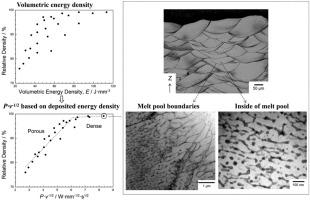Additive Manufacturing ( IF 10.3 ) Pub Date : 2020-05-15 , DOI: 10.1016/j.addma.2020.101308 Xing Qi , Naoki Takata , Asuka Suzuki , Makoto Kobashi , Masaki Kato

|
- •
This study focused on additive manufacturing (AM) of the Al–Fe binary alloy samples with a near-eutectic composition of 2.5 mass% Fe using the laser powder bed fusion (LPBF) process. The melt pool depth, relative density, and hardness of LPBF-fabricated Al–2.5Fe alloy samples under different laser power (P) and scan speed (v) conditions were systematically examined. The results provided optimum laser parameter sets (P = 204 W, v ≤ 800 mm s−1) for the fabrication of dense alloy samples with high relative densities >99%. Additionally, Pv-1/2, which is based on the deposited energy density model, was found to be a more appropriate parameter for additively manufacturing Al–2.5Fe alloy samples, and using it to simplify the relative densities of the samples made the determination of a threshold value for the laser parameters required to fabricate dense alloy samples. The microstructural and crystallographic characterization of the LPBF-built Al–2.5Fe alloy samples revealed a characteristic microstructure consisting of multi-scan melt pools that resulted from local melting and rapid solidification owing to laser irradiation during the LPBF process. Furthermore, a number of columnar grains with a mean width of 21 μm elongated along the building direction were also observed in the α-Al matrix. Numerous nano-sized particles of the metastable Al6Fe intermetallic phase with a mean size <100 nm were finely dispersed in the α-Al matrix. The hardness of the refined microstructure produced by the LPBF process was high at 90 HV, which is more than twofold higher than that of conventionally casted alloys that contain the coarsened plate-shaped Al13Fe4 intermetallic phase in equilibrium with the α-Al matrix.
中文翻译:

近共熔Al-Fe二元合金的激光粉末床熔合:加工和显微组织
- •
这项研究的重点是采用激光粉末床熔合(LPBF)工艺对具有近共晶成分的2.5质量%Fe的Al-Fe二元合金样品进行增材制造(AM)。系统地检查了在不同激光功率(P)和扫描速度(v)条件下LPBF制造的Al–2.5Fe合金样品的熔池深度,相对密度和硬度。结果提供了最佳的激光参数集(P = 204 W,v ≤800毫米小号-1致密合金试样具有高的相对密度> 99%的制造)。另外,Pv -1/2,它基于沉积的能量密度模型,被发现是用于增材制造Al–2.5Fe合金样品的更合适的参数,并使用它来简化样品的相对密度,从而确定了激光的阈值制造致密合金样品所需的参数。LPBF铸造的Al–2.5Fe合金样品的显微组织和晶体学表征显示了由多扫描熔池组成的特征微结构,该熔池是由于LPBF过程中的激光辐照引起的局部熔化和快速凝固而形成的。此外,许多柱状晶粒的平均宽度为在α-Al基体中也观察到沿构造方向拉长的21μm。平均尺寸<100 nm的亚稳态Al 6 Fe金属间相的许多纳米级颗粒均精细地分散在α-Al基体中。通过LPBF工艺生产的精制显微组织的硬度高90 HV,比包含与α-Al基体平衡的粗化板状Al 13 Fe 4金属间相的常规铸造合金高两倍以上。











































 京公网安备 11010802027423号
京公网安备 11010802027423号